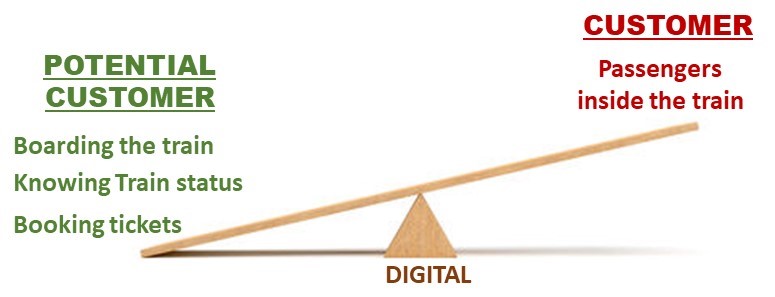As the train approached a station, a young lady asked co-passengers who were ready to alight, “Where do I find the milk for my little baby?” One of them answered, “Depends on the platform madam!”
We all face a variety of problems and challenges in our daily lives. The solutions or the method to overcome the challenges gradually become an integral part of our lives and we learn to live (unconsciously) with those problems. These are then considered as constraints under which we need to operate. In the previous post I shared a few ideas that were triggered due to the challenges of Bengaluru traffic. Problems, old and new, are good opportunities to be creative and generate new ideas. This post carries a few ideas which occurred because of the problems we observed during our recent train travel. With the fast-evolving new technologies, it is worth revisiting old problems and explore if they could be solved.
We had a plan to take a short break to Goa last month. Due to sudden changes in work schedule, I had to change (advance) the dates. We always prefer to take the train to Goa from Pune to maximize our time on the beautiful beaches of Goa. We tried Tatkal, but unfortunately, we got just one seat in AC-II class and had to book the remaining in Sleeper class.
On the date of departure, we checked the running status of train and reached Pune station accordingly. Unfortunately, the train kept getting delayed and finally arrived after two hours of wait time. We were told that this delay was due to track repair work between Pune and the earlier station (stop). The authorities were probably aware of this beforehand and ideally should have got reflected in the train running status.
During the wait time at Pune, I showed my son the digital board on the platform that indicated the position of our coach relative to the engine. We realized that the two coaches in which we had seats were several coaches apart, which increased my anxiety. The train arrived, and our coach was right in front of us, which impressed my son. I remembered the old days when there was panic on the platform to find the location of the coach and passengers were at the mercy of locals like coolies and shop owners.
The first few hours of the journey were fun, we played some board games and enjoyed the food served by the catering services of Indian Railways. After a few hours I was looking to snack again and decided to get out of the train at the next stop and get some local food. This is when I saw a young lady who was also planning to get down to get some milk for the little child.
We all got down at the next stop, took a few steps hurriedly towards left and right, but could not find any shop that would sell snack or milk. The fear of missing the train made us rush back into the train rather too soon. We felt we should have searched a little more.
This was the moment when I realized that perhaps the Indian railways has not thought enough about the need of the passengers who are inside the train. Almost all the improvements made in the last few years have been centered around people who would book the train ticket and then board the train. Why doesn’t Indian Railways look at the needs of passengers who are inside the train. If we focus on the passengers, we could generate several ideas that would solve the problems of passengers without much investments. Several such ideas could be turned into a revenue model by Indian Railways:
- Letting the passengers know the platform on which the train is approaching… a few minutes ahead of time. Information about the side on which the platform would be very useful for passengers travelling with lot of baggage in long distance trains.
- Google like map of all railway platforms clearly showing the location of various shops along with the list of items they sell with price
- Menu of all the all eateries on the platform and rating of their food – the way Zomato does
- A Swiggy type of food delivery system where the passengers can order food of their choice from the eateries of their choice… indicating their coach and seat number where the ordered food could be delivered. There are several methods to safeguard interest of both sides for this transaction.
- A notification to all the passengers 30 seconds before the departure of train so that people could return to their seats.
- Ability to call the cleaning staff in case there is an accidental spillage of food and beverage.
The research shows that Associative thinking is a key cognitive skill required to generate innovative ideas – and I believe Indians are very good at associative thinking. In the next post, I will share one more example (potholes) of how a very old problem could be partly solved because of the advent of new technologies. Who in the organization would unearth old problems/challenges and explore new ideas – It has to be Chief Innovation Evangelist/Officer.

